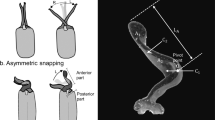Abstract
Ants of the ponerine genus Odontomachus employ a trap jaw mechanism for prey catching or defense. The mandible strike is released within less than 10 ms upon stimulation of particular mechanosensory trigger hairs. It is based on the storage of mechanical energy produced by the large but slow mandible closer muscle which cocks the mandible several seconds in advance of the strike.
The strike is released from the catch by a small trigger muscle composed of tubular fibers. It features fast potentials and highly synchronized activation of all its muscle fibers only a few milliseconds in advance of the strike. The trigger muscle is supplied by two unusually large motor neurons that are enclosed in a glial sheath. The trap jaw action is thus controlled by a system composed of 2 giant sensory and 2 giant motor neurons on either side. The giant neurons are most likely monosynaptically coupled. The large axon diameter and the synaptic coupling result in high conduction velocity which underlies the very fast mandible reflex. The reflex activity is modulated by antennal and other sensory input probably converging onto the large dendritic trees of the trigger motor neurons.
Similar content being viewed by others
Abbreviations
- ejps :
-
excitatory junctional potential
- SOG :
-
suboesophageal ganglion
References
Barth R (1960) Ueber den Bewegungsmechanismus der Mandibeln von Odontomachus chelifer Latr. (Hymenopt., Formicidae). An Acad Brasil Ciencias 32: 373–384
Bullock TH, Horridge GA (1965) Structure and function in the nervous system of invertebrates. W.H. Freeman and Co., San Francisco
Carlin NF, Gladstein DS (1989) The “bouncer” defense of Odontomachus ruginodis and other odontomachine ants (Hymenoptera: Formicidae). Psyche 96: 1–19
Dejean A, Bashingwa E (1985) La predation chez Odontomachus troglodytes Santschi (Formicidae — Ponerinae). Insecte Soc 32: 23–42
Eaton RC (1984) Neural mechanisms of startle behavior. Plenum, New York London
Faber DS, Korn H (1978) Neurobiology of the Mauthner cell. Raven, New York
Gronenberg W (1995) The fast mandible strike in the trap-jaw ant Odontomachus. I. Temporal properties and morphological characteristics. J Comp Physiol A 176: 391–398
Gronenberg W, Peeters C (1993) Central projections of the sensory hairs on the gemma of the ant Diacamma: substrate for behavioral modulation? Cell Tissue Res 273: 401–415
Gronenberg W, Tautz J (1994) The sensory basis for the trap-jaw mechanism in the ant Odontomachus bauri. J Comp Physiol A 174: 49–60
Gronenberg W, Tautz J, Hölldobler B (1993) Fast trap jaws and giant neurons in the ant Odontomachus. Science 262: 561–563
Günther J (1976) Impulse conduction in the myelinated giant fibers of the earthworm. Structure and function of the dorsal nodes in the median giant fiber. J Comp Neurol 168: 505–532
Guthrie DM (1980) Neuroethology (an Introduction). Blackwell Scientific Publ. Oxford London Edinburgh Boston Melbourne, pp 53–72
Hama K (1959) Some observations on the fine structure of the giant nerve fibers of the earthworm Eisenia foetida. J Biophys Biochem Cytol 6: 61–66
Heuser JE, Doggenweiler CF (1966) The fine structural organization of nerve fibers, sheaths, and glial cells in the prawn, Palaemonetes vulgaris. J Cell Biol 30: 382–403
Hölldobler B, Wilson EO (1990) The ants. Belknap Press of Harvard University Press, Cambridge Mass
Holmes W (1942) The giant myelinated nerve fibers of the prawn. Phil Trans R Soc Lond B 231: 293–311
Hoyle G (1975) The neural control of skeletal muscles. In: Usherwood PNR (ed) Insect muscle. Academic Press, London New York San Francisco, pp 501–543
Hoyle G (1983) Muscles and their neural control. Wiley, New York
Hudspeth AJ, Poo MM, Stuart AE (1977) Passive signal propagation and membrane properties in median photoreceptors of the giant barnacle. J Physiol Lond 272: 25–43
Jaffe K, Marcuse M (1983) Nestmate recognition and territorial behaviour in the ant Odontomachus bauri Emery (Formicidae: Ponerinae). Insectes Soc 30: 466–481
Josephson RK, Young D (1981) Synchronous and asynchronous muscles in cicadas. J Exp Biol 91: 219–237
Kanzaki R, Arbas E, Hildebrand JG (1991) Physiology and morphology of descending neurons in pheromone-processing olfactory pathways in the male moth Manduca sexta. J Comp Physiol A 169: 1–14
Kao CY, Grundfest H (1957) Postsynaptic electrogenesis in septate giant axons. I. Earthworm median giant axon. J Neurophysiol 20: 553–573
Kusano K (1966) Electrical activity and structural correlates of giant nerve fibers in Kuruma shrimp (Penaeus japonicus). J Cell Physiol 68: 361–384
Kusano K, La Vail MM (1971) Impulse conduction in the shrimp medullated giant fiber with special reference to the structure of functionally excitable areas. J Comp Neurol 142: 481–494
McAlear JH, Milburn NS, Chapman GB (1958) The fine structure of Schwann cells, nodes of Ranvier and Schmidt-Lanterman incisures in the central nervous system of the crab, Cancer irroratus. J Ultrastruct Res 2: 171–176
Milde JJ, Strausfeld NJ (1990) Cluster organization and response characteristics of the giant fiber pathwy of the blowfly Calliphora erythrocephala. J Comp Neurol 294: 59–75
Nicol JAC (1948) The giant nerve-fibres in the central nervous system of Myxicola (Polychaetae, Sabellidae). Q J Microp Sci 89: 1–45
Osborne MP (1975) The ultrastructure of nerve-muscle synapses. In: Usherwood PNR (ed) Insect muscle. Academic Press, London New York San Francisco, pp 151–205
Rehder V (1989) Sensory pathways and motor neurons of the proboscis reflex in the suboesophageal ganglion of the honey bee. J Comp Neurol 279: 499–513
Rushton WAH (1946) Reflex conduction in the giant fibres of the earthworm. Proc R Soc Lond B 133: 109–120
Strausfeld NJ, Bassemir U, Singh RN, Bacon JP (1984) Organizational principles of outputs from dipteran brains. J Insect Physiol 30: 73–93
Terakawa S, Hsu K (1991) Ionic currents of the nodal membrane underlying the fastest saltatory conduction in myelinated giant nerve fibers of the shrimp Penaeus japonicus. J Neurobiol 22: 324–352
Wheeler WM (1900) A study on some Texan Ponerinae. Biol Bull 2: 1–31
Author information
Authors and Affiliations
Rights and permissions
About this article
Cite this article
Gronenberg, W. The fast mandible strike in the trap-jaw ant Odontomachus . J Comp Physiol A 176, 399–408 (1995). https://doi.org/10.1007/BF00219065
Accepted:
Issue Date:
DOI: https://doi.org/10.1007/BF00219065




